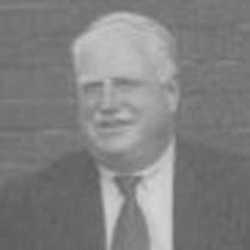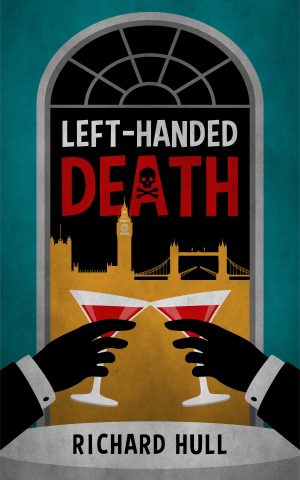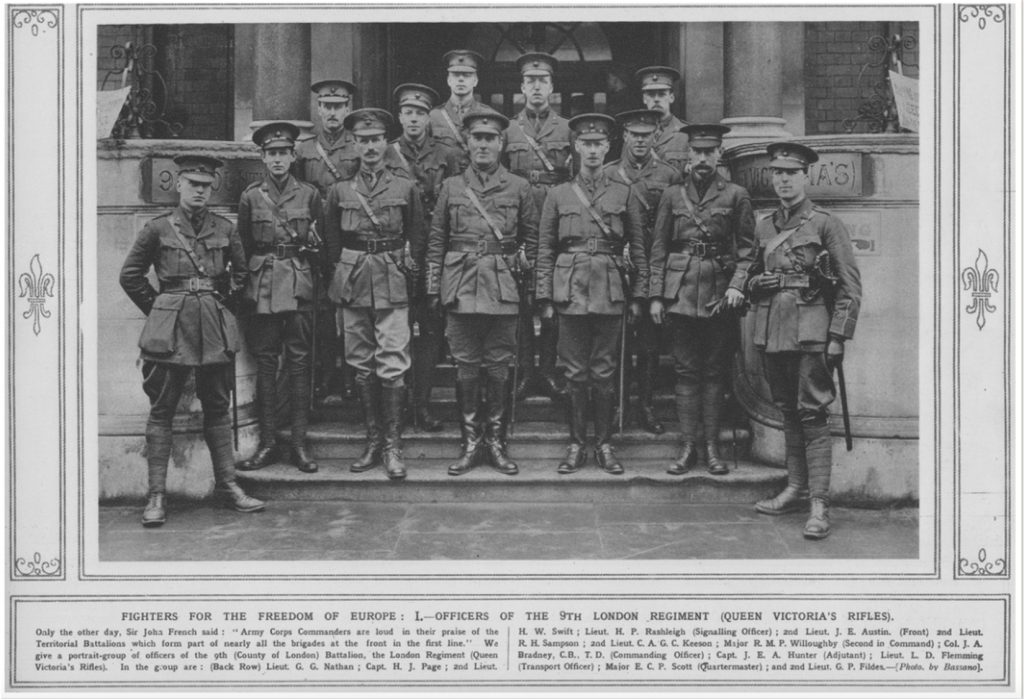
Major Richard Henry Sampson TD was a chartered accountant, “devoted son of the Regiment” and member of this Lodge for 45 years.
Born on 6 September 1896 in Kensington, Sampson was the son of Nina Hull and Samuel Arthur Sampson. He went to Rugby and was known to his friends as ‘Jumbo’ Sampson.
He volunteered at the age of 18, giving up a scholarship in mathematics at Trinity, Cambridge, instead gaining a commission with the Regiment. He served with them and attached to the Machine Gun Corps for the remaining three years of the war.
He is shown in the photograph below of the officers of the Reserve Battalion of the Victoria Rifles, formerly the 3/9th Battalion, with his fellow officers and Lodge members Cuthbert A C G Keeson, Lt Leonard Fleming, Maj Edwin Scott and the Adjutant James Hunter, and his CO Lt Col Bradney:
At the end of the war he worked for a firm of chartered accountants in the early 1920s and then later set up his own practice. He moved into full-time writing in 1934 after the success of his first crime novel The Murder of My Aunt, written under the pen name Richard Hull, taking his mother’s maiden name. He would go on the write fourteen more novels (see below).
He remained an active territorial with the Regiment until 1929. He returned to the Regiment with the rising threat of war with Germany raised its head again and became Company Commander of HQ Company. He was not considered for duty ‘overseas’ in 1939 and he was bitterly disappointed not to go to France with Colonel Ellison-Macartney and his friends and brethren.
The result of this however was to be spared internment in 1940. He maintained continuous contact with the Interned Officers throughout the war, writing “scores of letters each month from [the University] Club, in handwriting so small in generated complaints from British Censors” (Facing Fearful Odds: My Father’s Story of Captivity, Escape & Resistance. John Jay).
He became an auditor with the Admiralty in London, a position he retained until his retirement in the 1950s. While he ceased to write detective fiction after 1953, he did continue to take a close interest in the affairs of the Detection Club, assisting Agatha Christie with her duties as President.
He was a Fellow of the Institute of Chartered Accountants in England and Wales (ICAEW).
He was initiated in 1928 at the age of 32 and rose to become Worshipful Master in October 1934. He would again take the Chair between 1941 and 1943 at the height of the Second World War, and is to date the only member to be Worshipful Master four times, a feat he achieved in October 1969. He was Secretary from 1944 to 1969. He returned as Assistant Secretary in 1972. He wrote the Centenary History of the Lodge.
Grand Lodge awarded him LGR in 1947 and made him Senior Grand Deacon in 1963.
He died in 1973 at his home 32 Eccleston Square in Pimlico, London.
Major Boydell wrote of Sampson in the 1990 Lodge History:
“He was a bachelor, and loved his London flat, his club, his wine his books, his friends, his Regiment and the Lodge.”

Works
- The Murder Of My Aunt, (1934)
- Keep It Quiet, (1935)
- The Ghost It Was, (1936)
- Murder Isn’t Easy, (1936)
- The Murderers Of Monty, (1937)
- One Man’s Holiday, (1937) [written as: Henry DICKSON]
- Excellent Intentions, (1938) (title in US: Beyond Reasonable Doubt)
- And Death Came Too, (1939)
- My Own Murderer, (1940) (also titled: Murder By Invitation)
- The Unfortunate Murderer, (1941)
- Left-Handed Death, (1946)
- Last First, (1947)
- Until She Was Dead, (1949)
- Invitation To An Inquest, (1950)
- A Matter Of Nerves, (1950)
- The Martineau Murders, (1953)
